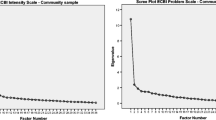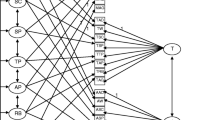Abstract
The aim was to determine whether ratings of 2- and 3-year-olds could yield more differentiation among their behavioral/emotional problems than the internalizing-externalizing dichotomy found in previous studies. The 99-item Child Behavior Checklist for Ages 2–3 (CBCL/2–3) was designed to extend previously developed empirically based assessment procedures to 2-and 3-year-olds. Factor analyses of the CBCL/2–3 completed by parents of 398 2- and 3-year-olds yielded six syndromes having at least eight items loading ≥ 30 and designated as Social Withdrawal, Depressed, Sleep Problems, Somatic Problems, Aggressive, and Destructive. Second-order analyses showed that the first two were related to a broad-band internalizing grouping, whereas the last two were related to a broad-band externalizing grouping. Scales for the six syndromes, two broad-band groupings, and total problem score were constructed from scores obtained by 273 children in a general population sample. Mean test-retest reliability r was 87, 1-year stability r was 69, 1-year predictive r with CBCL/4–16 scales at age 4 was 63, 2-year predictive r was 55, and 3-year predictive r was 49. Children referred for mental health services scored significantly higher than nonreferred children on all scales. A lack of significant r's with the Minnesota Child Development Inventory, Bayley, and McCarthy indicate that the CBCL/2–3 taps behavioral/emotional problems independently of the developmental variance tapped by these measures.
Similar content being viewed by others
References
Abramowitz, M., & Stegun, I. A. (1968).Handbook of mathematical functions. Washington, D.C.: National Bureau of Standards.
Achenbach, T. M. (1985).Assessment and taxonomy of child and adolescent psychopathology. Beverly Hills: Sage.
Achenbach, T. M., & Edelbrock, C. S. (1978). The classification of child psychopathology: A review and analysis of empirical efforts.Psychological Bulletin, 85, 1275–1301.
Achenbach, T. M., & Edelbrock, C. S. (1981). Behavioral problems and competencies reported by parents of normal and disturbed children aged four through sixteen.Monographs of the Society for Research in Child Development, 46, (Serial No. 188).
Achenbach, T. M., & Edelbrock, C. (1983).Manual for the Child Behavior Checklist and Revised Child Behavior Profile. Burlington: University of Vermont, Department of Psychiatry.
Achenbach, T. M., & Edelbrock, C. (1986).Manual for the Teacher's Report Form and Teacher Version of the Child Behavior Profile. Burlington: University of Vermont, Department of Psychiatry.
Achenbach, T. M., & Edelbrock, C. (1987).Manual for the Youth Self-Report and Profile. Burlington: University of Vermont, Department of Psychiatry.
Achenbach, T. M., & McConaughy, S. H. (1987).Empirically-based assessment of child and adolescent psychopathology: Practical applications. Newbury Park, CA: Sage.
Achenbach, T. M., McConaughy, S. H., & Howell, C. T. (1987). Child/adolescent behavioral and emotional problems: Implications of cross-informant correlations for situational specificity.Psychological Bulletin, 101, 213–232.
Bayley, N. (1969).Bayley Scales of Infant Development. New York: Psychological Corporation.
Behar, L. B., & Stringfield, S. (1974). A behavior rating scale for the preschool child.Developmental Psychology, 10, 601–610.
Cohen, J. (1977).Statistical power analysis for the behavioral sciences (rev. ed.). New York: Academic Press.
Cornely, P., & Bromet, E. (1986). Prevalence of behavior problems in three-year-old children living near Three Mile Island: A comparative analysis.Journal of Child Psychology and Psychiatry, 27, 489–498.
Crowther, J. H., Bond, L. A., & Rolf, J. E. (1981). The incidence, prevalence, and severity of behavior disorders among preschool-age children in day care.Journal of Abnormal Child Psychology, 9, 23–42.
Earls, F. (1980). The prevalence of behavior problems in 3-year-old children. Comparison of the reports of mothers and fathers.Journal of the American Academy of Child Psychiatry, 19, 439–452.
Edelbrock, C., Costello, A. J., Dulcan, M. K., Kalas, R., & Conover, N. C. (1985). Age differences in the reliability of the psychiatric interview of the child.Child Development, 56, 265–275.
Evans, W. R. (1975). The Behavior Problem Checklist. Data from an inner city population.Psychology in the Schools, 12, 301–303.
Feild, H. S., & Armenakis, A. A. (1974). On use of multiple tests of significance in psychological research.Psychological Reports, 35, 427–431.
Fischer, M., Rolf, J. E., Hasazi, J. E., & Cummings, L. (1984). Follow-up of a preschool epidemiological sample: Cross-age continuities and predictions of later adjustment with internalizing and externalizing dimensions of behavior.Child Development, 55, 137–150.
Goyette, C. H., Conners, C. K., & Ulrich, R. F. (1978). Normative data on revised Conners Parent and Teacher Rating Scales.Journal of Abnormal Child Psychology, 6, 221–236.
Heinstein, M. (1969).Behavior problems of young children in California. Berkeley: California Department of Public Health.
Hollingshead, A. B. (1975).Four Factor Index of Social Status, Unpublished manuscript, Yale University, Department of Sociology.
Ireton, H., & Thwing, E. J. (1974).Minnesota Child Development Inventory. Minneapolis: Behavior Science Systems.
Kohn, M. (1977).Social competence, symptoms, and underachievement in childhood: A longitudinal perspective. New York: Wiley.
Kohn, M., & Rosman, B. L. (1972). A social competence scale and symptom checklist for the preschool child: Factor dimensions, their cross-instrument generality, and longitudinal persistence.Developmental Psychology, 6, 430–444.
Kohn, M., & Rosman, B. L. (1973). A two-factor model of emotional disturbance in the young child: Validity and screening efficiency.Journal of Child Psychology and Psychiatry, 14, 31–56.
McCarthy, D. (1972).McCarthy Scales of Children's Abilities. New York: Psychological Corporation.
McGuire, J., & Richman, N. (1986). Screening for Behavior problems in nurseries: The reliability and validity of the Preschool Behavior Checklist.Journal of Child Psychology and Psychiatry, 27, 7–32.
Miller, L. C. (1981).Louisville Behavior Checklist Manual. Los Angeles: Western Psychological Services.
Minde, R., & Minde, K. (1977). Behavioural screening of pre-school children: A new approach to mental health? In P. J. Graham (Ed.),Epidemiological approaches to child psychiatry (pp. 139–164). London: Academic Press.
Quay, H. C. (1986). Classification. In H. C. Quay & J. S. Werry (Eds.),Psychopathological disorders of childhood (3rd ed.). New York: Wiley.
Quay, H. C., & Peterson, D. R. (1983).Interim Manual for the Revised Behavior Problem Checklist. Coral Gables, Florida: University of Miami, Applied Social Sciences.
Rauh, V., Achenbach, T. M., Nurcombe, B., Howell, C. T., & Teti, D. M. (in press). Minimizing adverse effects of low birthweight: Four-year results of an early intervention program.Child Development.
Richman, N. (1977). Is a behavior checklist for preschool children useful? In P. J. Graham (Ed.),Epidemiological approaches to child psychiatry (pp. 125–136). London: Academic Press.
Richman, N., & Graham, P. (1971). A behavioral screening questionnaire for use with three year old children: Preliminary findings.Journal of Child Psychology and Psychiatry, 12, 5–33.
Richman, N., Stevenson, J., & Graham, P. J. (1975). Prevalence of behavior problems in three-year-old children: An epidemiological study in a London borough.Journal of Child Psychology and Psychiatry, 16, 222–287.
Richman, N., Stevenson, J., & Graham, P. J. (1982).Pre-school to school: A behavioral study. London and New York: Academic Press.
Sakoda, J. M., Cohen, B. H., & Beall, G. (1954). Test of significance for a series of statistical tests.Psychological Bulletin, 51, 172–175.
Author information
Authors and Affiliations
Additional information
This research was supported by March of Dimes Birth Defects Foundation Grants 12–88 and 12–186, a Faculty Scholars Award from the W.T. Grant Foundation, and a Biomedical Research Support Grant from the University of Vermont College of Medicine.
Rights and permissions
About this article
Cite this article
Achenbach, T.M., Edelbrock, C. & Howell, C.T. Empirically based assessment of the behavioral/emotional problems of 2- and 3- year-old children. J Abnorm Child Psychol 15, 629–650 (1987). https://doi.org/10.1007/BF00917246
Revised:
Issue Date:
DOI: https://doi.org/10.1007/BF00917246




